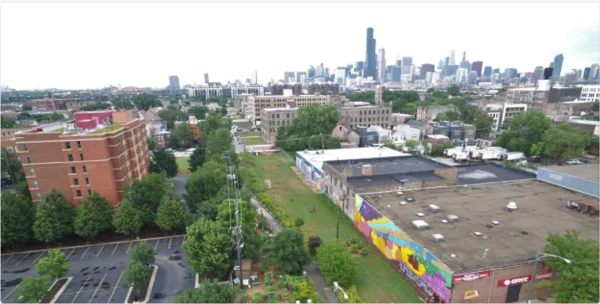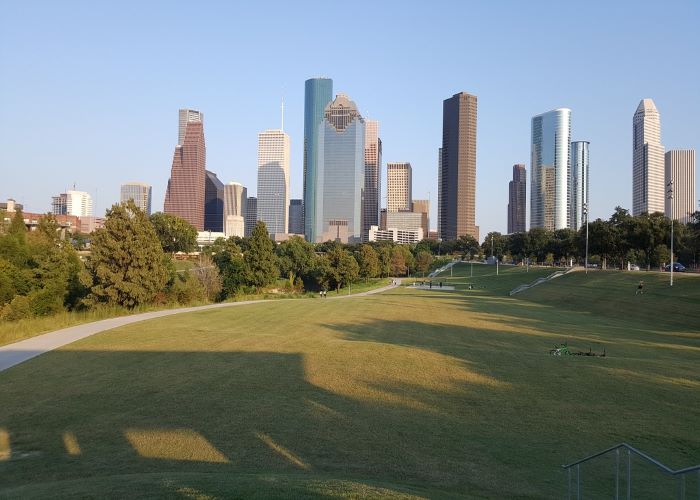If you would like to receive weekly updates like this, sign up here.
There has been a major row between the neighbours of two closely located suburbs.
In the historically Latino neighbourhoods of Pilsen and Little Village in Chicago a proposed multi-use pathway called El Paseo is bringing the idea of green space into sharp focus.
The plan is to build this path alongside the existing Burlington Northern Santa Fe rail line, which has become abandoned.
 Source: El Paseo Trail
Source: El Paseo Trail
The proposed project would create more green space and provide a much easier method of navigating between home and work by using the former railway tracks via wide bike paths surrounded by park benches and manicured gardens.
All this is feeding into a brand-new term used to describe such investments.
As communities around the world emerge from their lockdowns, governments are using taxpayer funds to pay for programs to get the economy moving again. One of the things that emerged from our lockdown experiences was the importance of being close to a good park so you can enjoy the natural environment.
However, that’s not all that’s happening.
I’m about to show you an example of how such ‘investments’ are going to ruin you and your family’s future.
How the outcome of what appears to be a noble endeavour gets so horribly distorted that the same public for whom these are designed for end up being unable to use them and leave.
Will the same thing happen to you?
After reading this, I bet you’ll think long and hard the next time you are asked to lobby your local council for something similar.
Green Gentrification.
The brand-new term I referred to above is green gentrification.
Let’s break it down.
The green part should be obvious.
It’s a desire to add more nature and natural beauty to what is for the most part concrete jungles in most downtowns and central business district areas.
It includes park clean-ups, riverbank restorations and bioremediations, often promoted by community activism from local groups.
Gentrification is described via the Merriam-Webster dictionary as;
“a process in which a poor area (as of a city) experiences an influx of middle-class or wealthy people who renovate and rebuild homes and businesses…results in an increase in property values and the displacement of earlier, usually poorer residents.”
When you look at it logically, it’s a weird combination of words.
The green calls for introducing more space, more natural lighting, and surrounds.
And yet, gentrification is the displacement of former residents via a combination of better-off and wealthy citizens and increases to the price of property and rents such that the former residents are forced out of their areas.
What do you think of the term now? It sounds a bit sinister to me.
And this is exactly how the residents of Pilsen and Little Village in Chicago are beginning to feel too.
And they are correct to do so.
They point to a similar development in a nearby Chicago suburb completed in 2015 called the 606 trail which resulted in huge property price spikes.
Your contents fantastic. I use it more for my real estate dealings rather than stock trading and it’s a real help. Keep up the good work!
Oscar, Melbourne.
This is how the 606 trails official website describes it.
“What was an abandoned rail line is now the 606! Its 2.7 miles of multi-use recreational trail and park is an alternate transportation corridor, a living work of art and a spectacular new green space for all to enjoy.”
A living work of art. That sounds great, doesn’t it?
But it’s not that which makes this initiative, on the surface at least, very attractive for city dwellers.
Most urbanists and economists have long thought that gentrification is driven by the desire of people to reduce their commutes to their offices and workplaces.
But it is apparent that more is at work here.
Gentrification is also driven by a desire to be close to unique urban amenities like restaurants, galleries, museums, and the like.
Alessandro Rigolon and Jeremy Nemeth from the Universities of Utah and Colorado respectively investigated this.
Their research takes a close look at the role of urban parks and green spaces in gentrification.
The study covers 10 cities in different regions of the country.
This group includes five of the very biggest cities, including Chicago, that have seen significant gentrification.
Their research tracks the role of parks in the gentrification of these cities.
The authors dub neighbourhoods that start out with median incomes lower than that of the city as “gentrification-eligible.”
Under this definition, about half the tracts in these cities were eligible in the year 2000 (56 percent in Chicago).
This was further broken down by focusing on several key characteristics of parks and their effect on gentrification.
These are: size, overall quality, whether they are new, proximity to downtown, and whether they are linear “greenway parks,” longer than a mile, that include bike lanes.
Is sustainability without equality worth it?
Here is the upshot, and your key takeaway.
It turns out it isn’t parks or green spaces per se that spur this green gentrification.
It’s the type of parks and their characteristics which play a greater role.
The first big finding is that long greenway parks are the biggest culprits in gentrification.
Being located within a half-mile of a new greenway park increases the odds that a neighbourhood will gentrify by more than 200 percent.
Five of seven new greenway parks in the study spurred significant gentrification including New York’s High Line, Chicago’s 606 trail, and Houston’s Buffalo Bayou Park.
The reason for this is likely the simple fact that long linear greenway parks provide ample opportunities for new real estate development along their lines.
Ah-ha!
I knew it. This has zero to do with creating something good for the public and instead it is specifically designed to help landlords and property developers.
It means the long-time advocates of green gentrification are unable to stay and experience the benefits they once fought for.
“What we’re seeing is that attempting to be green often ends up building on the same inequalities that got us here in the first place,” said Winifred Curran, an urban geographer and professor of geography at Chicago’s DePaul University.
Is this not madness? Or is it by design?
The case for green developments highlights sustainability but leaves out equity in the process.
This is exactly what is concerning the residents of Pilsen and Little Village.
They now see how the race for the unearned gains these types of investments generate benefit the few at the expense of the many.
Look around your neighbourhood, are there similar green gentrification plans mooted for your suburb?
Do you rent? Could you cope with the increases in rent? What if you have plans to buy soon in the same area?
Can you save enough to stay ahead of the land price increases?
If the answer to both is no, likely you and your family are about to be pushed aside.
Should you feel unfairly treated, or let down by your local governments?
Perhaps, but I think the response should be different.
I think it’s time to educate yourself; start here with the Boom Bust Bulletin.
It will teach you the history of the 18.6-year Real Estate Cycle, why it continues to repeat and how it manifests opportunities that you can take advantage of.
The fact the land captures these gains once manifested is supposed to happen, it’s natural.
This forms the entire structure of our economic system. Designed to enrich the few over the many.
Is “a living work of art and a spectacular new green space for all to enjoy” worth losing the dream of living alongside your children?
Don’t suffer the negative effects this irresponsible environmental and planning process will bring.
Get educated, prepare yourself ahead of time and make sure you become the ‘few’ whom this policy is designed to enrich.
It’s not fair, but it is the real estate cycle.
And you are part of it.
It’s time to win. Join up for just $4USD a month, incredible value.
Best regards,

Darren J Wilson
and your Property Sharemarket Economics Team
P.S. – If you would like to receive weekly updates like this, sign up here.
P.P.S – Find us on Twitter here and go to our Facebook page here.



